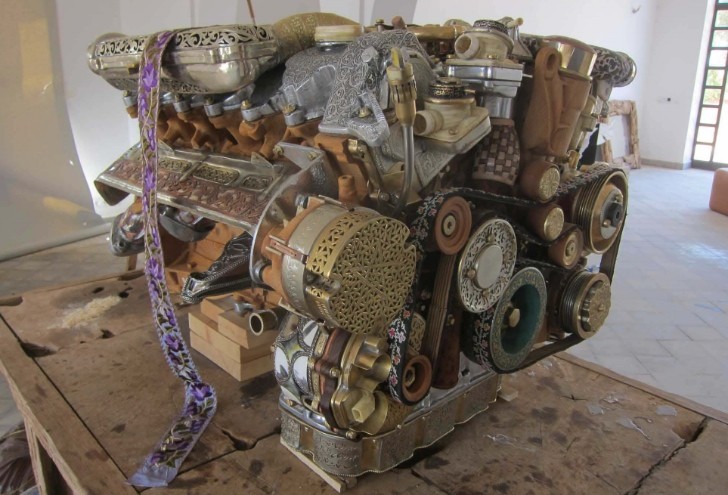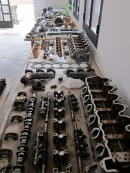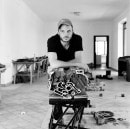In what could very well earn the title of the week's/month's or even the year's most unusual Mercedes-Benz related event, a Belgian sculptural artist hand built a Mercedes-Benz V12 engine from no less than 53 different materials, most of which would have never been found on a real combustion engine before.
It all started when Eric van Hove received a Cda-Projects Grant to deconstruct a Mercedes-Benz V12 engine down to every component and then duplicate each and every element in different materials found all over the Moroccan region, where the artist also has a residency.
The idea itself is more anal retentive than a watchmaker with OCD, but the result is even more outlandish. We are talking about 465 different parts and 660 bolts out of casted copper recreated at the slightest detail and spiced up a bit with some Moroccan history design elements.
The V12 Laraki, as the project is called, seems to be based on an old M120 Mercedes V12, which was actually the three-pointed star's first ever V12 fitted to a road-going, production vehicle. Different versions of the engine have powered everything from the W140 S-Class to the Pagani Zonda or the CLK-GTR, and it is known as being literally bullet-proof and the lightest V12 which was ever mass-produced.
These are the 53 different materials found in the art engine, in case you also want to have a go at a similarl far out project by yourself (sure you will):
Middle Atlas white cedar wood, high Atlas red cedar wood, walnut wood, lemon wood, orange wood, ebony wood of Macassar, mahogany wood, thuya wood, Moroccan beech wood, pink apricot wood, mother-of-pearl, yellow copper, nickel plated copper, red copper, forged iron, recycled aluminum, nickel silver, silver, tin, cow bone, goat bone, malachite of Midelt, agate, green onyx, tigers eye, Taroudant stone, sand stone, red marble of Agadir, black marble of Ouarzazate, white marble of Béni Mellal, pink granite of Tafraoute, goatskin, cowskin, lambskin, resin, cow horn, rams horn, ammonite fossils of the Paleozoic from Erfoud, Ourika clay, geometric terra cotta with vitreous enamel (zellige), green enamel of Tamgrout, paint, cotton, argan oil, cork, henna and rumex.
Story via This Is Colossal
The idea itself is more anal retentive than a watchmaker with OCD, but the result is even more outlandish. We are talking about 465 different parts and 660 bolts out of casted copper recreated at the slightest detail and spiced up a bit with some Moroccan history design elements.
The V12 Laraki, as the project is called, seems to be based on an old M120 Mercedes V12, which was actually the three-pointed star's first ever V12 fitted to a road-going, production vehicle. Different versions of the engine have powered everything from the W140 S-Class to the Pagani Zonda or the CLK-GTR, and it is known as being literally bullet-proof and the lightest V12 which was ever mass-produced.
These are the 53 different materials found in the art engine, in case you also want to have a go at a similarl far out project by yourself (sure you will):
Middle Atlas white cedar wood, high Atlas red cedar wood, walnut wood, lemon wood, orange wood, ebony wood of Macassar, mahogany wood, thuya wood, Moroccan beech wood, pink apricot wood, mother-of-pearl, yellow copper, nickel plated copper, red copper, forged iron, recycled aluminum, nickel silver, silver, tin, cow bone, goat bone, malachite of Midelt, agate, green onyx, tigers eye, Taroudant stone, sand stone, red marble of Agadir, black marble of Ouarzazate, white marble of Béni Mellal, pink granite of Tafraoute, goatskin, cowskin, lambskin, resin, cow horn, rams horn, ammonite fossils of the Paleozoic from Erfoud, Ourika clay, geometric terra cotta with vitreous enamel (zellige), green enamel of Tamgrout, paint, cotton, argan oil, cork, henna and rumex.
Story via This Is Colossal

















